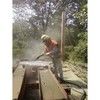We are getting ready to frame a garage on a sloped slab. Any suggestions for an easy way to cut the studs to length? The slab is not the best so interpolation is out of the question. The slab has a 3″ over 26′ slope. The slab is sloped for water runoff. I am looking for different ides to measure the studs. We have a laser and a level.
Tim
Edited 5/16/2003 8:51:00 AM ET by tim
Edited 5/16/2003 9:07:41 AM ET by tim




















Replies
Tim,
How far is the slab out of level? The easiest way would be to shim the sill plates. If it's really messed up, you could cut each stud to length, but in the end, if the difference is great, your siding, etc. might get messed up. Another option could be self leveling concrete/cement?
Quality before Quantity
Set some stakes and run a level string line around the perimiter. Figure out how tall you want the wall, and how far that is above the string. Then measure from the string down and add the 2 dimensions.
If the slab is that bad, are you sure you want to be building on it? It's awfully hard to replace the slab after the shell is there......
If blind people wear dark glasses, why don't deaf people wear earmuffs?
What we do on nearly every garage we frame is to layout and detail the plates. Bolt the mudsill down and layout the topplate right next to it. The we shoot in all the corners with a transit so they are level. We then set the corners in plumb and run a string from the top of one corner to another. Layout all the studs on the slab like you would if you were going to nail the wall together, but put each stud on it's layout mark on the mudsill and then stand it up and lightly touch the string. Then cut the stud on the chalkmark.
I'm not sure if that makes sense or not. This will make the top of the garage walls level all the way around. You could always set your mudsill so it projects away from the slab a little, then your siding can hang low and cover the difference in slab heights.
We use this method to frame basement walls. The slab can be all over the place, but you'll still end up with a level floor if it's a basement or level plates to frame your roof on.
This really isn't a time consuming method either. It's just a little wordy to explain :-)
there are always many ways to do anything but what i always try to do is keep it simple but accurate. for years i was in a production framing crew and would experiment with timing different methods. it was a way to avoid boredom as much as anything else but it taught me a lot. i remember one job i had doing piece work framing semi custom tract homes in the san francisco bay area (union job) at break one day not long after starting the foreman decided to be nice and help the new guy by telling me the proper way to frame a rake wall. in the field they only give us short point and long point, the rest is up to us to figure. for once in my life i kept my damn mouth shut and listened politely not bothering to tell him that in just the previous year i had a job where for six months i did nothing but frame rake walls as all the square walls were built in a shop somewhere and trucked to sight. i didnt even have to stand my walls i just left them on the ground where they lay, so i didn't bother to tell the foreman who was trying to be nice and help me that his way was two short cuts ago for me and i knew because i had timed it over and over again on the same floor plan. what works for one may not work for all. keep it simple but make it accurate. fix it correctly if it is not right. speed will come with time and repetition. and shortly after you get enough repetition to get fast you get really sick of it and are looking for something different
so you gonna share your little secret or just brag about knowing it?
BTw...it's called common difference....
unit rise squared + unit run(12") squared = square root times the on center(in feet)
...is how I'd punch it into the calculator...once I find that..either keep adding to the short point or subtracting from the long point.
What your trick?
JeffBuck Construction Pittsburgh,PA
Fine Carpentery.....While U Waite
We agree...
Ditto Timhuller's post...a slight variation of this would be to use a double bottom plate. Bolt the first one in place and transfer the layout marks to the other bottom plate and the top plate. Now go ahead and stand each stud up and mark it against the stringline ( actually, a chalkline used as a stringline). Use a 2 ft level to hold against the stud when positioning to keep the stud plumb when standing it on mudsill layout mark.
Now after obtaining chalk mark, measure 1-1/2 inches down from that mark (thickness of the other bottom plate) and cut your stud. Number each stud in sequence. After you finish marking, cutting, and numbering all studs in that run of wall, assemble your wall on the ground in normal fashion, then raise it up in place and nail it in place atop the bottom mudsill.
You use extra plate material in this fashion, but it saves a lot of toenailing if done the other way. If you use the double bottom plate method, use treated plating for the bottom ( bolted in place) mudsill, then use regular stock for everything else.
Davo